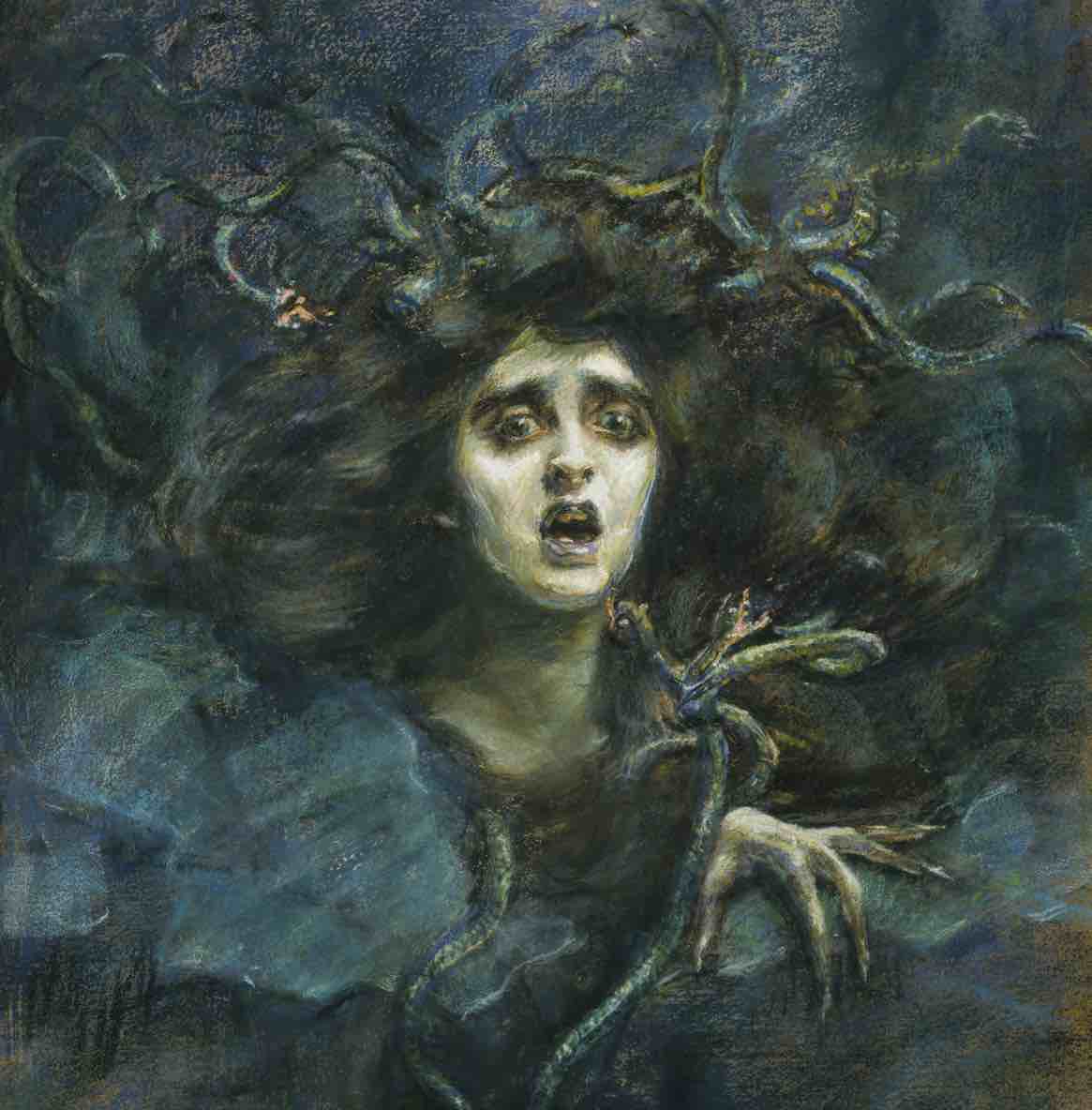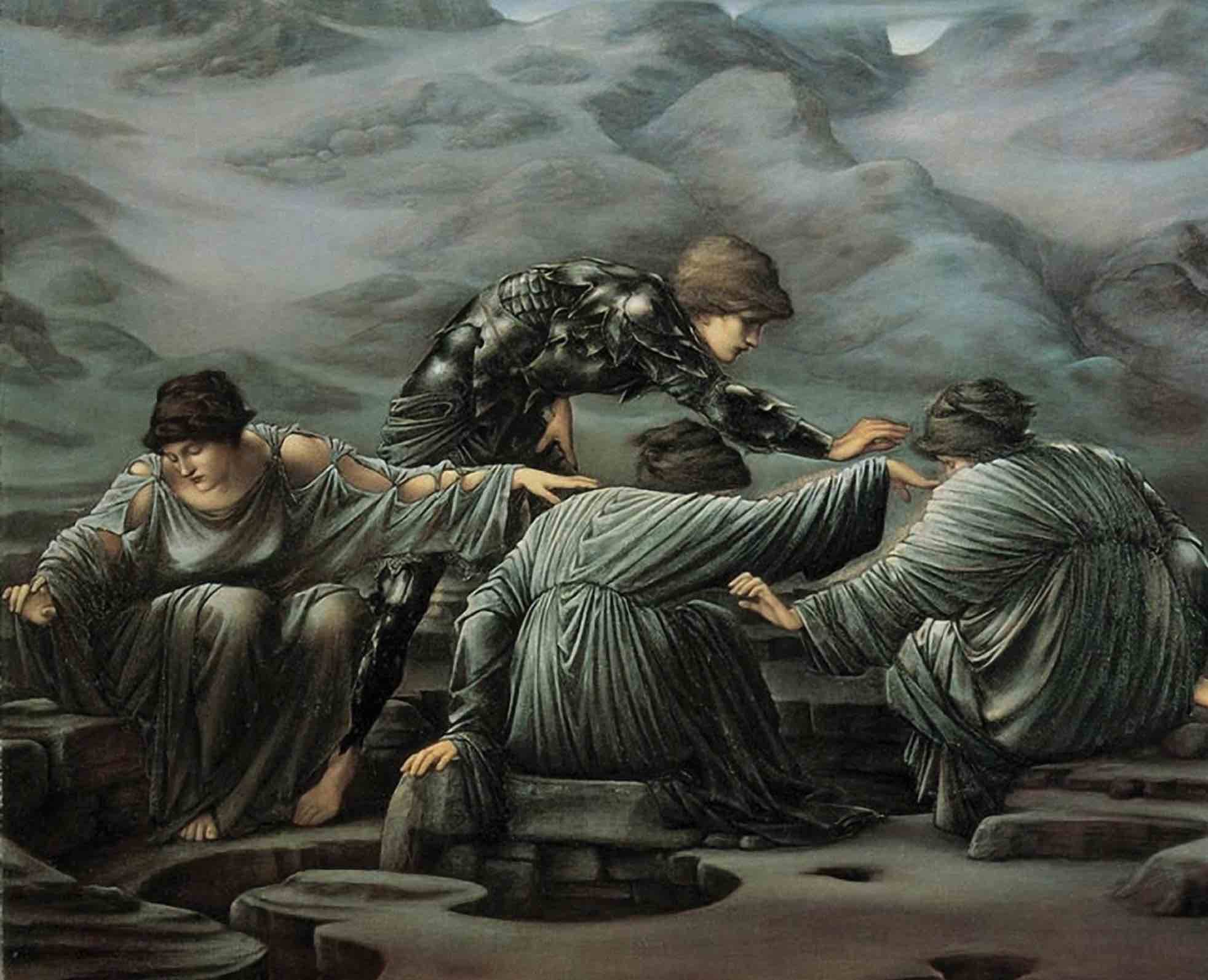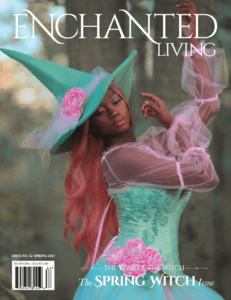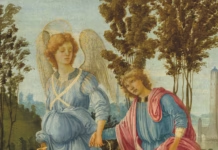We know Shakespeare’s Scottish play so well that if we are actors, we dare not speak its name aloud, lest we bring a terrible
fate upon the production—and maybe ourselves. We especially love the women in it, the three Weird Sisters and Lady Macbeth: Whenever the would-be King of Scotland waffles, they are there to lure or goad him onward. We shiver with dread from the moment the curtain lifts and witches walk onstage, asking, “When shall we three meet again? In thunder, lightning, or in rain?” All of the above, please—we’re looking forward to it.
Everyone looks forward and onward in this play, plotting to get what they want as they have their fortunes told. It’s when they look back on what they’ve done that things really get crazy. So yes, the witches say, they need to meet as soon as a certain Macbeth and Banquo stumble through the storm. It seems the trio commonly known as the Weird Sisters have a plan. Here’s a hint: They chant the paradoxical creed that sets up the play’s delightfully tormented plot: “Fair is foul, and foul is fair,” before taking off
“through the fog and filthy air.”
So, fellow audience, what do we think: Can a Scotsman with big dreams put his trust in these paradox-spouting witches? Well, why the murky hell not? We want to see what happens when he does. This is Shakespeare; we know that by the end, almost everyone who matters will be dead.
That’s how the wyrds work.
Because, you see, the modern text is deceptive. In the First Folio—the first printed version of the play, which appears in a collection dating to 1623 these sisters are not weird, they are “weyward”: likely to lead someone astray. Both words are related to the Anglo-Saxon wyrd, meaning fate. So the deceitful sisters are more than strange, more than spooky: They are the Fates of classical myth, duplicitous, sly, capable of spinning a plotline and cutting it short for sheer fun. Proof that life is what happens when we’re busy making other plans. And—oh, Will, you can be so prim!—that trusting in any sort of necromancy is a very bad way to run your life.
Cases in point: When another supernatural sororal triad crosses Macbeth’s storyline within the tartan of the play, they knot it up. A deep dive into mythology shows that gruesome threesomes tend to outmatch Willful humans.
The Weyward Plot
First, a refresher on the twists and led-astrays of the play itself. When Macbeth and his friend Banquo stumble in fresh from a battle, they greet the sisters in a most ungallant manner. Banquo does most of the talking here, asking his friend, right in front of the witches themselves,
—What are these, So withered, and so wild in their attire,
That look not like th’ inhabitants o’ th’ Earth
And yet are on ’t?
Chivalry dies entirely when he turns to the sisters and demands:
—Live you? Or are you aught That man may question?
Oh no, he should not have said question. The sisters deliver some cryptically worded prophecies that boil down to this: Macbeth will become Thane of Cawdor, then king. Banquo, however, will be the father of kings, “Lesser than Macbeth and greater.” “Not so happy and yet much happier.” All this even though King Duncan has two sons of his own who stand to inherit.
In the next scene, Macbeth finds out that he is in fact now Thane of Cawdor and has just enough time to prepare for a visit from King Duncan. He sees yet another paradox: “Nothing is but what is not”—that is, nothing seems to exist except what hasn’t happened yet. Which must mean that the future is bright, correct? Correct, says his Lady. She even thinks they can hurry the prophecy along if her husband only screws his courage to the sticking place. He does, and they tidy up the mess together.
The next morning, after a visitor discovers the body, Duncan’s two sons flee in fear for their lives. Macbeth seizes the crown … and at the same time is seized by paranoia, because the more you have, the more you have to lose. What about Banquo’s future kings? Easy enough: Have a henchman murder the man and his son. But the son escapes, and then Banquo’s ghost comes haunting, and Lady Macbeth isn’t as cuddly as expected …
Panicking, Macbeth seeks comfort with the witches. You know this scene; you’ve likely chanted, “Double, double, toil and trouble / Fire burn and cauldron bubble,” a time or two yourself.
The Weyward ones conjure a series of ghosts. The spirits predict that Macbeth will rule Scotland until Birnam Wood comes to his castle (Impossible! he thinks in relief), and that no man of woman born will be able to hurt him. (There’s no other way to be born, hurrah!) But the mood goes down when he insists on asking about the Banquo thing. A series of eight figures appear, wearing crowns, with Banquo’s ghost at the end, grinning and pointing proudly at the kings.
By the by, the actual monarch King James I (who was also James VI of Scotland) was considered to be descended from Banquo in the ninth generation, which essentially puts him into the play too. When it was performed at court, all eyes must have gone to him at this moment.
Devastated, Macbeth shakes himself free of the enchantments, only to hear that his wife has gone mad and Duncan’s son Malcolm has raised an army and is about to attack.
The battle resolves the paradoxes. The sisters’ predictions left a few parts out, or Macbeth interpreted them too literally. Malcolm’s army camouflages itself with branches tied to their helmets; it looks to Macbeth as if Birnam Wood has arrived. And when the late King Duncan’s old friend Macduff swoops toward Macbeth, sword out, he clarifies an important point: Macduff was never born per se, but “from his mother’s womb untimely ripped.”
Whoops. Fair is foul when you trust the wyrd.
Fateful Sources
This wild story, including the three witches, comes from Scottish history as it had been established in Shakespeare’s day. It’s also a product of its time, of course—a time when witches (and supernatural sisters) were very much on the public’s mind, as something bad and real and dangerous.
Shakespeare wrote the 2,100-line tragedy around 1606, when King James I occupied a united throne. Nineteen years earlier, James’s mother, Mary Queen of Scots, had been executed for treason and, in some accounts, also accused of witchcraft. A mere ten years after that, James published his own Daemonologie, a hefty investigation of witchcraft, fortune telling, and, yes, all manner of demons, broken tidily down into four categories.
Shakespeare’s other major source was Raphael Holinshed’s 1577 Chronicles of England, Scotland, and Ireland. It was Holinshed who dubbed the witches of Scottish history “the weird sisters, that is (as ye would say) the goddesses of destinie.” Shakespeare went with weyward because he was Shakespeare, and he had wey more words and plays inward.
I am tempted to point out a pattern among the sources here: 1577, 1587, 1597 … But there is danger in appearing to trust too much to numeric coincidence. Under the rules of Daemonologie, one might be accused of attempted divination. Shakespeare broke the pattern by presenting the play at court in 1606 —or so we are told. We can’t be sure it wasn’t 1607, or what that would mean. So much of the past is a fiction, rewritten to fulfill the prophecy of the present.
The Cruel Fates
The three Fates of classical mythology make the play’s witches seem like playful kittens. These sisters give you life, but they also make you suffer and die. When a child is still in utero, Clotho starts spinning the threads of its life, twisting them on her spindle. Lachesis is the measurer, deciding how much life an individual gets—and how many troubles. Atropos cuts the thread, determining when you’ll shuffle off your mortal coil. Not one of them is known for compassion.
The Weyward Sisters may horrify Macbeth and Banquo with their beards and otherworldly appearance, and nobody would call them sisters of mercy, but still—the gals do have a sense of humor that the Fates do not. They know they’re not nice; they revel in that. And yet I, at least, get the sense that they aren’t exactly malicious. When Macbeth demands to know more about the Banquo prophecy, they do warn him, “Seek to know no more.”
Maybe they mean it. Or maybe they know the warning will drive him crazy with desire to know, because the true transgression—in the play and in King James’s Daemonologie—may be neither murder nor even ambition but saying that we find supernatural approval for the bad things we do to get ahead. It’s out of my hands, you might say; it’s fate.
But, my lord, is it? The three witches may conjure visions and prophecies, but are they really in charge of Macbeth’s fate? We don’t see them scheming to do anything but talk to him. So they are no longer Holinshed’s “goddesses of destinie”; they are impish tricksters who may try to tweak destiny but do not control it. This is the 1600s; we believe free will exists.
To quote another play, “The fault, dear Brutus, is not in our stars but in ourselves.”
A Beautiful Gorgon
Sometimes the old gods got a bit kicked around too, just like mortals. When King Duncan’s old friend Macduff stops by Macbeth’s place to say hello, it becomes his fate to discover the bloody corpse. Then he rushes to Lennox and Macbeth, thundering, “Approach the chamber, and destroy your sight / With a new Gorgon!”
Unaware that his host has in fact already seen the sight (and done the deed), Macduff is saying that it’s too horrible for words, but, you know, the others may as well look and be petrified too—if not literally turned to stone, at least scared senseless. And so another set of Wyrd Sisters enter the play’s world.
When we speak of Gorgons, we usually mean three sisters born to the primordial Greek sea god Phorcys and goddess Ceto: Stheno, Euryale, and Medusa, who is the most famous, the youngest, and the only one we know to have been both mortal and beautiful. At least according to the later Roman poet Ovid, Medusa was born so beautiful that Neptune (Poseidon) fell in love with her, and he acted upon his passion in a temple dedicated to Minerva (Athena) … which made straitlaced Minerva so angry that she turned Medusa’s beautiful golden locks into snakes and made her so hideous that one look at her would turn all humans and some gods into stone.
That’s right, Gorgons can be created, not just born, and you don’t want to cheese off the wrong goddess. But there is power in scary looks as well as beautiful ones—and in the old stories, an ugly woman was less vulnerable than a pretty one. I think it’s appropriate that Medusa’s name means “queen.”
There was (is?) some good in all three Gorgon sisters, though you had to know how to find and use it. When Medusa’s dying blood hit the sea, for example, two children were born, one of them Pegasus. If you took blood from the right side of a Gorgon, you had a healing elixir; if you took it from the left side, you got a nasty poison. Even now, people decorate their homes with pictures of Gorgons to scare evil away.
Lonely, confined to an island, tremendously powerful but unable to use those powers themselves, hunted down for sport … I want to give them all a hug. Their sisters, though … another story.

The Graeae
Shakespeare’s witches have even more in common with another set of girls born to Phorcys and Ceto. The Graeae came out of the womb already aged and gray-haired, sometimes identified individually as Alarm, Horror, and Dread. They lived on their own island and plotted the destruction of cities.
Why? Well, why does anyone want to do such things? Because we’re hurt and we want to hurt back. And because, for the various supernatural sister trios, it’s fun to mess with humans and their little plans.
But the Grays’ global destruction is probably even now stuck at the plot stage. Not only were these sisters born old and world-weary, they also had just one eye and one tooth to share. They had to hand the bits around, taking turns.
The imperfect vision shared by three women ties right back into the Weyward Sisters; their own sight is fine, but they delight in others’ blind spots. (What fun!) Some of the visions they give Macbeth are as slyly confusing as their words are; he puts a lot of faith in what he sees, even when he addresses a soliloquy to a phantom dagger: “Mine eyes are made the fools o’ th’ other senses / Or else worth all the rest.” Whether his eyes are being tricked or functioning better than any other sense, the hallucination guides him toward what he really wants, which is to kill Duncan. So off he goes to the murder, inspired by a knife that he himself suspects is “a false creation from the heat-oppressèd brain.”
This soliloquy makes some people think Macbeth is already as batty as his Lady will be later. With their tunnel vision, the ill-fated couple lay waste to their little corner of Scotland.
The Graces
Not all bevies of three were hideous, malevolent, cold-hearted, or scheming. Some were party girls. The Graces, for example, devoted their immortality to beauty and pleasure, their time to hosting celebrations for the gods and inspiring creativity in humankind. Many a statue and brooch has been fashioned in their honor—usually three girls with arms entwined, clad in filmy frocks or not at all.
We need only remember what ambition did to Lady Macbeth to see the dangers this alluring trio might pose. Inspiration goes hand in hand with ambition, showing a mortal how to get what she wants. Be careful what you wish for—especially once you figure out how to get it.
Case in point: Lady Macbeth did not plan ahead for her own conscience, which sees Duncan’s blood soaking her palms. Her sleepwalking, hand-scrubbing scene is one of the play’s greatest moments:
Out, damned spot—out, I say! […] Hell is murky … Fie, my lord, fie! A soldier, and afeard? What need we fear who knows it, when none
can call our power to account? Yet who would have thought the old man to have had so much blood in him?
Well, we did rather hope he would … This little speech shows the uselessness of planning, as Lady M mingles the present (the imagined stain, the murky hell) with the past (the moment just before the stabbing). She thought there would be nothing to fear in a future in which she and her husband would be all-powerful, but her scheme failed to account for mundane details such as the volume of blood in the human body. With a mind tangled in a fatal web, Lady Macbeth will commit suicide in the last act.
Coincidentally, the Graces were also associated with the underworld as part of the annual Eleusinian Mysteries, which celebrated Persephone’s return from Hades. Persephone’s symbolic rebirth offered the possibility of an afterlife, and the Graces were the promise of beauty and joy in it.
So maybe there’s hope for the Macbeths after all. Or maybe Banquo’s ghost is the only one who deserves any joy at all.
Hell is murky indeed.

The Fate of the Folio
Also murky, some scholars point out, is the Scottish play itself. It is the shortest of Shakespeare’s tragedies (and among the shortest of his plays in general); it seems to leave a few things out. For example, this question is so widespread it’s almost a folkloric joke in its own right: How many children does Lady Macbeth have? If Macbeth wants his kids, rather than Banquo’s, to carry on as kings, shouldn’t we know that they … exist? Shakespeare was a fan of foils and doubles (and triples!), so it does seem odd that the families aren’t set up for comparison.
And is Macbeth himself barmy, or only his lady? She hallucinates in her sleepwalking scene; he hallucinates in his soliloquy and quite possibly when he sees those future kings.
Most of all, Why don’t we see more of the witches? They’re everybody’s favorite part.
The play had never been published before the First Folio of 1623, when Shakespeare had been dead for seven years. The text had to be cobbled together from handwritten passages and actors’ memories of playing the roles. It is often speculated that they simply forgot some.
But perhaps there were lines and scenes that they edited out as they recited—perhaps some deemed unlucky by 1623, when James I was in the last years of his life. Or an editor, transcriptionist, or typesetter may have taken it upon himself to remove incendiary bits later on—some versions of the Folio are considered more accurate than others.
Or … perhaps it wasn’t just a fault of the transcription or of actors’ faulty memories or editing. Perhaps Atropos cut Macbeth and Macbeth off too early.
There, I wrote out the title at last—let the Wyrd Sisters come for me too!































